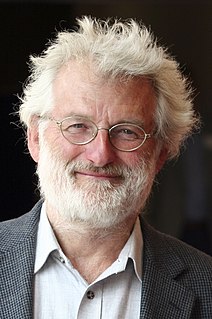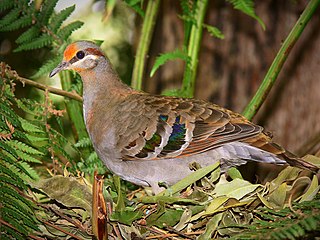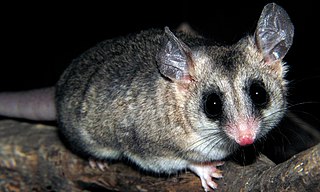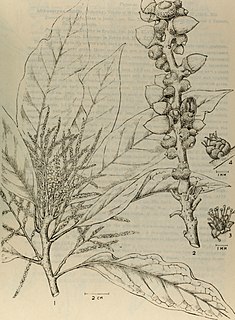
Caenorhabditis elegans is a free-living transparent nematode about 1 mm in length that lives in temperate soil environments. It is the type species of its genus. The name is a blend of the Greek caeno- (recent), rhabditis (rod-like) and Latin elegans (elegant). In 1900, Maupas initially named it Rhabditides elegans. Osche placed it in the subgenus Caenorhabditis in 1952, and in 1955, Dougherty raised Caenorhabditis to the status of genus.

Sydney Brenner was a South African biologist. In 2002, he shared the Nobel Prize in Physiology or Medicine with H. Robert Horvitz and Sir John E. Sulston. Brenner made significant contributions to work on the genetic code, and other areas of molecular biology while working in the Medical Research Council (MRC) Laboratory of Molecular Biology in Cambridge, England. He established the roundworm Caenorhabditis elegans as a model organism for the investigation of developmental biology, and founded the Molecular Sciences Institute in Berkeley, California, United States.

Howard Robert Horvitz is an American biologist best known for his research on the nematode worm Caenorhabditis elegans, for which he was awarded the 2002 Nobel Prize in Physiology or Medicine, together with Sydney Brenner and John E. Sulston, whose "seminal discoveries concerning the genetic regulation of organ development and programmed cell death" were "important for medical research and have shed new light on the pathogenesis of many diseases".

Sir John Edward Sulston was a British biologist and academic who won the Nobel Prize in Physiology or Medicine for his work on the cell lineage and genome of the worm Caenorhabditis elegans in 2002 with his colleagues Sydney Brenner and Robert Horvitz. He was a leader in human genome research and Chair of the Institute for Science, Ethics and Innovation at the University of Manchester. Sulston was in favour of science in the public interest, such as free public access of scientific information and against the patenting of genes and the privatisation of genetic technologies.

The spermatheca, also called receptaculum seminis, is an organ of the female reproductive tract in insects, e.g. ants, bees, some molluscs, oligochaeta worms and certain other invertebrates and vertebrates. Its purpose is to receive and store sperm from the male or, in the case of hermaphrodites, the male component of the body. Spermathecae can sometimes be the site of fertilization when the oocytes are sufficiently developed.

Banksia elegans, commonly known as the elegant banksia, is a species of woody shrub that is endemic to a relatively small area of Western Australia. Reaching 4 m (13 ft) high, it is a suckering shrub that rarely reproduces by seed. The round to oval yellow flower spikes appear in spring and summer. Swiss botanist Carl Meissner described Banksia elegans in 1856. It is most closely related to the three species in the subgenus Isostylis.

The elegant crested tinamou or martineta tinamou is a medium-sized tinamou that can be found in southern Chile and Argentina in shrubland.

The Nubian flapshell turtle or Nubian soft-shelled turtle is one of two species of softshell turtle in the genus Cyclanorbis of the Trionychidae family. It has historically been found in a wide range spanning Benin, Central African Republic, Chad, Ethiopia, Ghana, Nigeria, Sudan, and Togo. However, it has been very rarely recorded during the last 50 years and there is little hope that the species is extant in Ghana, Benin, Togo, Nigeria and Cameroon. In early 2019, a remnant population was found in the White Nile wetlands in South Sudan by Prof. Luca Luiselli and his team.

The brush bronzewing is a species of bird in the pigeon family, Columbidae. It is endemic to Australia, with two biogeographically distinct subspecies.

The elegant fat-tailed mouse opossum, also known as the Chilean mouse opossum, is an opossum from central Chile. The type species of Thylamys, it was first described by English naturalist George Robert Waterhouse in 1839. This medium-sized opossum is characterized by black rings around the eyes, white limbs, gray to light brown coat, lighter flanks and underbelly and a thick 12.7–14.6 centimetres (5.0–5.7 in) long tail covered with hairs. It is crepuscular and lives in nests in tree hollows or under rocks and roots. This opossum feeds mainly on arthropods and larvae apart from fruits. Litter size is typically between 11 and 13. The elegant fat-tailed opossum can occur in a variety of habitats – from cloud forests to chaparrals. The IUCN classifies the opossum as least concern.

The elegant water shrew is a species of mammal in the subfamily Soricinae of the family Soricidae. It is monotypic within the genus Nectogale. It lives in Sikkim and China.

Eudromia is a genus of birds in the tinamou family. This genus comprises two crested members of this South American family.

Galipea is a genus of plant in family Rutaceae.

Cornelia Isabella "Cori" Bargmann is an American neurobiologist. She is known for her work on the genetic and neural circuit mechanisms of behavior using C. elegans, particularly the mechanisms of olfaction in the worm. She has been elected to the National Academy of Sciences and had been a Howard Hughes Medical Institute investigator at UCSF and then Rockefeller University from 1995 to 2016. Since 2016 she is Head of Science at the Chan Zuckerberg initiative. In 2012 she was awarded the $1 million Kavli Prize, and in 2013 the $3 million Breakthrough Prize in Life Sciences.

Victor R. Ambros is an American developmental biologist who discovered the first known microRNA (miRNA). He is a professor at the University of Massachusetts Medical School in Worcester, Massachusetts.
Gary Bruce Ruvkun is an American molecular biologist at Massachusetts General Hospital and professor of genetics at Harvard Medical School in Boston. Ruvkun discovered the mechanism by which lin-4, the first microRNA (miRNA) discovered by Victor Ambros, regulates the translation of target messenger RNAs via imperfect base-pairing to those targets, and discovered the second miRNA, let-7, and that it is conserved across animal phylogeny, including in humans. These miRNA discoveries revealed a new world of RNA regulation at an unprecedented small size scale, and the mechanism of that regulation. Ruvkun also discovered many features of insulin-like signaling in the regulation of aging and metabolism. He was elected a Member of the American Philosophical Society in 2019.

Conchocarpus is a plant genus in the family Rutaceae.

Lithocarpus elegans is a tree in the beech family Fagaceae. The specific epithet elegans is from the Latin meaning "elegant", referring to the acorns and cupules.

Kyphosus elegans, the Cortez sea chub or Cortez chub, is a species of marine ray-finned fish, a sea chub from the family Kyphosidae. It is found in the eastern Pacific Ocean where it is of minor importance to commercial fisheries.
















